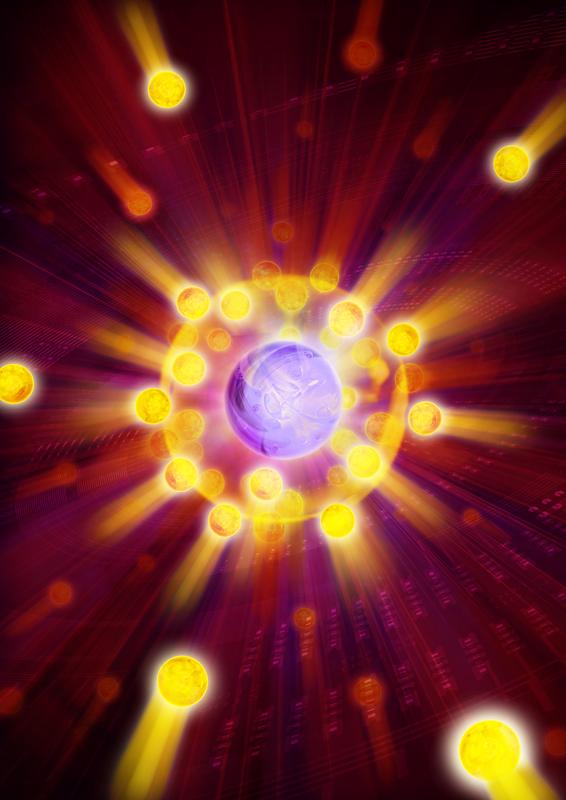Observing the Birth of Quasiparticles in Real Time

Researchers have studied quasiparticle dynamics in real time. IQOQI/Harald Ritsch
The concept of quasiparticles is a powerful tool to describe processes in many-body quantum systems, such as solid-state materials. For example, when an electron moves through a solid, it generates polarization in its environment because of its electrical charge.
This “polarization cloud” moves together with the electron and the resulting “dressed electron” can be theoretically described as quasiparticle or a polaron. “You could picture it as a skier on a powder day,” says Grimm. “The skier is surrounded by a cloud of snow crystals. Together they form a system that has different properties than the skier without the cloud.”
The challenge in an experiment is to measure the quasiparticles. “These processes last only attoseconds, which makes a time-resolved observation of their formation extremely difficult,” explains Grimm. His research group uses ultracold quantum gases for simulations to study the many-body physics of complex quantum systems.
Observing the birth of quasiparticles
Ultracold quantum gases are an ideal experimental platform to study physical phenomena in solid-state materials and also exotic states of matter, for example neutron stars. Because of the well-controlled environment, the scientists are able to create many-body states and manipulate interactions between particles in these gases. Rudolf Grimm’s research group, working at the Institute for Quantum Optics and Quantum Information, Austrian Academy of Sciences, and the Institute for Experimental Physics, University of Innsbruck, is a leader in this research field.
In collaboration with theoretical physicists from Harvard University, the TU Munich and Monash University in Australia, the researchers have now studied quasiparticle dynamics in real time. In a vacuum chamber, using laser trapping techniques, the researchers created an ultracold quantum gas made up of lithium atoms and a small sample of potassium atoms in the center. For both types of atoms they used isotopes of fermionic nature, which belong to the same fundamental class as electrons.
Magnetic fields were used to tune interactions, which produced Fermi polarons, i.e. potassium atoms embedded in a lithium cloud. “In condensed matter, the natural time scale of these quasiparticles is on the order of 100 attoseconds,” explains Grimm. “We simulated the same physical processes at much lower densities. Here, the formation time for polarons is a few microseconds.”
However, measurement still remains a challenge. “We developed a new method for observing the ‘birth’ of a polaron virtually in real time,” says quantum physicists Grimm. Looking into the future, he says: “This may turn out to be a very interesting approach to better understand the quantum physical properties of ultrafast electronic devices.”
The scientists are supported, among others, by the Austrian Science Fund (FWF) within the framework of the Special Research Area program (SFB) FoQuS and the Doctoral Program Atoms, Light and Molecules (ALM).
Publication: Ultrafast many-body interferometry of impurities coupled to a Fermi sea. Marko Cetina, Michael Jag, Rianne S. Lous, Isabella Fritsche, Jook T. M. Walraven, Rudolf Grimm, Jesper Levinsen, Meera M. Parish, Richard Schmidt, Michael Knap, Eugene Demler. Science 2016 DOI: 10.1126/science.aaf5134
Contact:
Rudolf Grimm
Institute for Experimental Physics
University of Innsbruck
Phone: +43 512 507-52410
Email: rudolf.grimm@uibk.ac.at
Web: http://www.ultracold.at
Christian Flatz
Public Relations Office
University of Innsbruck
Phone: +43 512 507 32022
Mobile: +43 676 872532022
Email: christian.flatz@uibk.ac.at
http://dx.doi.org/10.1126/science.aaf5134 – Ultrafast many-body interferometry of impurities coupled to a Fermi sea. Marko Cetina, Michael Jag, Rianne S. Lous, Isabella Fritsche, Jook T. M. Walraven, Rudolf Grimm, Jesper Levinsen, Meera M. Parish, Richard Schmidt, Michael Knap, Eugene Demler. Science 2016
http://www.ultracold.at – Research Group Ultracold Atoms and Quantum Gases
http://iqoqi.at – Institute of Quantum Optics and Quantum Information (IQOQI)
Media Contact
All latest news from the category: Physics and Astronomy
This area deals with the fundamental laws and building blocks of nature and how they interact, the properties and the behavior of matter, and research into space and time and their structures.
innovations-report provides in-depth reports and articles on subjects such as astrophysics, laser technologies, nuclear, quantum, particle and solid-state physics, nanotechnologies, planetary research and findings (Mars, Venus) and developments related to the Hubble Telescope.
Newest articles

Superradiant atoms could push the boundaries of how precisely time can be measured
Superradiant atoms can help us measure time more precisely than ever. In a new study, researchers from the University of Copenhagen present a new method for measuring the time interval,…

Ion thermoelectric conversion devices for near room temperature
The electrode sheet of the thermoelectric device consists of ionic hydrogel, which is sandwiched between the electrodes to form, and the Prussian blue on the electrode undergoes a redox reaction…

Zap Energy achieves 37-million-degree temperatures in a compact device
New publication reports record electron temperatures for a small-scale, sheared-flow-stabilized Z-pinch fusion device. In the nine decades since humans first produced fusion reactions, only a few fusion technologies have demonstrated…





















